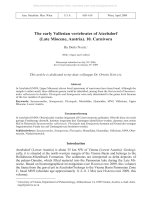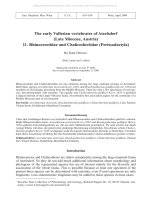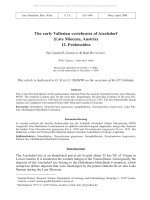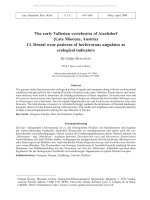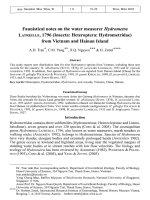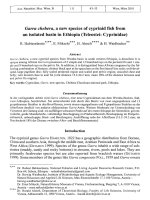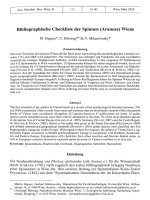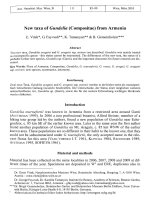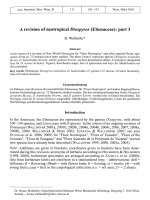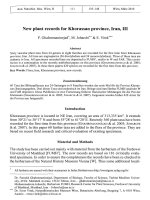Annalen des k. k. naturhistorischen Hofmuseums 100B 0301-0341
Bạn đang xem bản rút gọn của tài liệu. Xem và tải ngay bản đầy đủ của tài liệu tại đây (8.28 MB, 41 trang )
©Naturhistorisches Museum Wien, download unter www.biologiezentrum.at
Ann. Naturhist. Mus. Wien
100 B
301-341
Wien, Dezember 1998
Revision of New Guinea Copelatus ERICHSON, 1832
(Insecta: Coleoptera: Dytiscidae):
The running water species, Part I
M. Balke"
"To an ecologist, and to all biologists,
it is a happy hunting ground
of endless surprises
and unanswered questions".
J.L. GRESSIT 1982, talking about New Guinea.
Abstract
Copelatus (Papuadytes), new subgenus, is erected to receive the New Guinea running water species of the
genus Copelatus ERICHSON, 1832. Copelatus atratus BALFOUR-BROWNE, 1939 and C. nomax BALFOUR-
BROWNE, 1939 were assigned to that subgenus here. Thirty-one new Papuadytes species are described:
Copelatus aipo sp.n., C. aipomek sp.n., C. ascendens sp.n., C. astrophallus sp.n., C. bacchusi sp.n., C. broschii
sp.n., C. casuarinus BALKE & HENDRICH sp.n., C. damantiensis sp.n., C. danae sp.n., C. erteldi sp.n., C.
formosus sp.n., C.fume sp.n., C. heidiae sp.n., C. inornatus sp.n., C.jaseminae sp.n., C. karmurensis sp.n,
C. ketembang sp.n., C. larsoni sp.n., C. manfredi sp.n., C. me sp.n., C. miriae sp.n., C. monae sp.n., C.
patepensis sp.n., C. rivulus sp.n. (type species), C. rufus sp.n., C. sanctimontis sp.n., C. speciosus BALKE &
HENDRICH sp.n., C. takime sp.n., C. talaki sp.n., C. tarmluensis sp.n., C. ullrichi sp.n. Important characters
are illustrated. What is known on the species ecology is summarized.
Key words: Dytiscidae, genus Copelatus, Papuadytes, revision, new species, new subgenus, New Guinea.
Zusammenfassung
Für die Fließwasserarten auf Neu Guinea der Gattung Copelatus ERICHSON, 1832 wird die neue Untergattung Papuadytes errichtet. Die bereits bekannten Arten Copelatus atratus BALFOUR-BROWNE, 1939 und
C. nomax BALFOUR-BROWNE, 1939 werden hier in diese Untergattung gestellt. Einunddreißig neue PapuadytesArten werden beschrieben: Copelatus aipo sp.n., C. aipomek sp.n., C. ascendens sp.n., C. astrophallus sp.n.,
C. bacchusi sp.n., C. broschii sp.n., C. casuarinus BALKE & HENDRICH sp.n., C. damantiensis sp.n.,
C. danae sp.n., C. erteldi sp.n., C.formosus sp.n., C.fume sp.n., C. heidiae sp.n., C. inornatus sp.n., C.
jaseminae sp.n., C. karmurensis sp.n., C. ketembang sp.n., C. larsoni sp.n., C. manfredi sp.n., C. me sp.n.,
C. miriae sp.n., C. monae sp.n., C. patepensis sp.n., C. rivulus sp.n. (Typusart), C. TM/WS sp.n., C.
sanctimontis sp.n., C. speciosus BALKE & HENDRICH sp.n., C. takime sp.n., C.frz/a&/sp.n., C. tarmluensis
sp.n., C. ullrichi sp.n. Alle wichtigen Strukturen werden abgebildet. Es wird zusammengefaßt, was derzeit
zur Ökologie der Arten bekannt ist.
Michael Balke, AG Evolutionsbiologie, Institut für Zoologie, Freie Universität Berlin, Königin-LuiseStraße 1 - 3, D-14195 Berlin, Germany (e-mail <> & <>).
©Naturhistorisches Museum Wien, download unter www.biologiezentrum.at
302
Annalen des Naturhistorischen Museums in Wien 100 B
Introduction
At present, 18 species of Copelatus are known from mainland New Guinea, islands offshore, and the Bismarck Archipelago (GUIGNOT 1956, GUÉORGUIEV 1968, 1978,
GUÉORGUIEV & ROCCHI 1993). Several expeditions I carried out in New Guinea and a
subsequent screening of museum collections revealed a large number of additional species.
This had to be expected as the Copelatinae, especially the genus Copelatus, are one of the
most species-rich groups of Dytiscidae in areas under tropical and subtropical climates.
Some 500 species of Copelatinae have been named; and the discovery of numerous new
species is fully being expected.
This is the first part of a revision dealing with New Guinean Copelatus. It treats a morphologically and ecologically rather distinct group of species; i.e. small beetles which
1.) always lack elytral striae and / or strioles, 2.) have a symmetrical median lobe of
aedeagus in dorsal / ventral view and 3.) are always associated with running water.
I here erect Papuadytes, new subgenus of Copelatus, for taxonomic purposes. Monophyly of this subgenus will be shown in a cladistic analysis within part II. of the revision
of rheobiotic New Guinea Copelatus.
Materials and Methods
This study is based on some 1500 individuals. Besides in the collections mentioned in
the text, by 1999 reference specimens will be deposited in the Zoological Museum of
Bogor (Indonesia) and the PUSPPENSSAT-IRJA reference collection, Nabire, Irian
Jaya, Indonesia.
Collections
BMNH - The Natural History Museum (formerly British Museum, Natural History),
London, UK. (Mr S.J. Hine)
cGW - Collection of Prof. Dr Günther Wewalka, Vienna, Austria
cHF - Collection of Dr Hans Fery, Berlin, Germany
cLH - Collection of Lars Hendrich, Berlin, Germany
cMB - Author's collection
MCSN - Museo Civico di Storia Naturale "Giacomo Doria", Genoa, Italy. (Dr. R. Poggi)
MHNG - Muséum d'Histoire Naturelle, Geneva, Switzerland. (Dr. I. Lobi)
NMW - Naturhistorisches Museum Wien, Austria. (Dr. M.A. Jäch)
Measurements were taken with the beetle in a horizontal position using a Wild M8 binocular with an ocular micrometer (12 mm with 0.1 mm steps) at 25 x.
I prefer to provide the total length minus head (Tl-h) because the total length including
the head strongly depends on the head's actual orientation. Tl-h is about 90 - 96 % of the
total length.
Illustrations of the genitalia, tarsomeres and prosternai processes were traced from
SEMs taken with a Philips SEM 515 at 120 x. Drawings of the antennae were made with
a drawing tube attached to a Leitz Laborlux K, 63 x.
©Naturhistorisches Museum Wien, download unter www.biologiezentrum.at
BALKE: Revision
303
of New Guinea Copelatus, Part I (Coleoptera: Dytiscidae)
Finotarra Mti
by Bacchus
n 1964/65
appro* poem of
arsa u m p l e d along
trek Natxre-llaga
in 1990/91 and 1996
t30*E
132'
134*
Heaog Mis
campTed by Baechu«
1964/ 65
9' -
136*
Fig. 1: Approximate position of locations from which specimens were sampled so far. Most
smaller ranges omitted.
When referring to the ventral aspect of the median lobe of aedeagus the orientation
during copulation is considered.
Abbreviations
Morphology: Lp - length of pronotum medially; MesoT - mesotarsomere; ProT -protarsomere; Tl-h - total length of beetle minus head; TW - total width of beetle; Wpb -width
of pronotum basally.
Others: a.s.l. - above sea level; IR 90#ll, IR 92#11 etc. - codes of sampling sites for
which a separate checklist is available (from author or NMW); PNG - Papua New
Guinea.
Geographical localization of sampling sites
Two maps are here provided for orientation (Figs. 1, 2). Different sources were consulted to locate stations sampled:
Irian Jaya
- The Nabire area explored by L. Hendrich and myself in 1990/91, and re-visited by me
in 1996, can hardly be located on available maps. The sites are all situated along the
road from Nabire to Ilaga, which is still under construction. I provide the kilometre
distance from Nabire as indicated on tables along the road for the stations sampled. In
some cases, I was able to locate positions with a GPS satellite navigation device, at
least 3 satellites being used (3 D mode).
©Naturhistorisches Museum Wien, download unter www.biologiezentrum.at
304
Annalen des Naturhistorischen Museums in Wien WO B
Eastern Jayawiyaya Chain
Main Watershed (N-S)
Fig. 2: Detail map of E central WNG depicting the area sampled by Balke in 1992/93, roughly
marked as grey rectangle on Fig. 1.
- The area I visited in 1992/93 is covered by a Landsat-1-scenes based map provided by
HELMCKE & al. (1983), which is probably the best map available at the moment (map
Eastern Jayawijaya and Western Sepik regions). I have redrawn the area sampled for
better orientation (Fig. 2).
PNG
- Stations visited by M. Bacchus were, when possible, located on Tactical Pilotage
Charts (TPC) M-13B, M-13C, and M-14D. The same is true for the areas visited by
W. Ullrich, and DJ. Larson. These maps are available from large bookstores.
I was unable to locate PNG: Mafulu (type locality of C. nomax) and PNG: Sepik Province:
Selminum tern (sp. 4, see appendix).
Taxonomy
I here mainly provide a detailed description of those characters which are present in all
the species studied. Species descriptions are thus rather short and contain characters of
diagnostic value only. The group studied here is rather homogenous, so that the male
genitalia need to be examined for reliable species identification in most cases. Often,
females cannot be assigned to species.
©Naturhistorisches Museum Wien, download unter www.biologiezentrum.at
BALKE: Revision of New Guinea Copelatus, Part I (Coleoptera: Dytiscidae)
305
Papuadytes subgen.n.
Type species: Copelatus {Papuadytes) rivulus, sp.n., by present designation.
Diagnosis: Body elongate oval, unicolorous, reddish to dark brown or castaneous. Dorsal
surface without striae and / or strioles. Median lobe of aedeagus of male symmetrical in
most species (exception: C. astrophallus). Pro- and mesotarsomeres of male not dilated
(exception: C. ullrichi). Always associated with running water.
Preimaginal stages: unknown.
Size of beetles: Tl-h: 3.12 - 5.92 mm. Refer to Table 1 for more measurements.
Head: Clypeus slightly concave anteriorly, not beaded. Frons with two short rows of
setiferous punctures present laterally on level of front edge of eyes. A distinct row of
punctures visible alongside of lateral and anterior margin of the eyes. Surface covered
with small regular meshes. These are rather more deeply incised posteriorly behind level
of middle of eyes, and especially laterally behind posterior margin of eyes. Puncturation
visible. Punctures are not evenly distributed but generally more numerous on posterior
portion than anteriorly. Punctures absent laterally behind posterior margin of eyes.
Colour ferrugineous to castaneous brown, somewhat darker behind the eyes.
Mentum distinctly microreticulate, anterior margin beaded medially; medially between
the labial palps with anterior margin slightly to distinctly concave and distinctly beaded
(Fig. 7).
Labium in ventral view with anterior margin gently rounded to somewhat tectiform,
densely setose along anterior margin except for lateral angles; medio-laterally with few
setae on both sides; medially convex and microreticulate, smooth and concave laterally
(Fig. 7). Dorsally with anterior margin spiny, and lateral margins densely setose.
Labrum strongly concave medially (Fig. 7). Dorso-medially densely setose; ventromedially with a field of spines anteriorly and densely setose posteriorly; ventro-laterally
with few spines.
Mandibles stout, triangular, slightly elongate. Inner margins densely setose ventrally;
subapically also with an isolated setal field. For shape see Fig. 7.
Lacinia with deeply impressed meshes medio-basally, medio-anteriorly densely covered
with small spiny scale-like structures. Surface otherwise smooth. Basally with numerous
short, stout setae (some 10 - 20). Inner margin densely setose, setae all long and more
or less stout. Apically with a second, inner, setal row (Fig. 7).
Antenna eleven-jointed. Antennomeres long and slender and/or globular. Some antennomeres may be greatly enlarged in the male, but females with slightly enlarged antennomeres also occur. In some species, male and female antennae are equal in size and shape,
but sexual dimorphism with at least some male antennomeres being larger than corresponding female joints is common. Refer to Figures 8 - 1 6 and species descriptions for
detailed information.
Pronotum: Distinct lateral bead present in most species, but obsolescent or reduced in
some. Refer to systematic analysis for detailed information. Widest at base or almost at
base, continuously narrowing towards anterior margin. Anterior angle acute, posterior
©Naturhistorisches Museum Wien, download unter www.biologiezentrum.at
306
Annalen des Naturhistorischen Museums in Wien 100 B
Taxon
aipo
aipomek
ascendens
astrophallus
atratus
bacchusi
broschii
casuarinus
damantinensis
Stn38
Stn82
Stn95
danae
erteldi
formosus
fume
heidiae
inornatus
jaseminae
10
1
4
1
5
4
5
2
3
1
2
4
3
1
3
0
5
5
5
5
5
1
5
5
10
10
6
2
7
6
8
1
5
3
3
2
TL-h (mean)
4.12-4.48(4.29)
4.12-4.32(4.23)
4.00-4.16(4.07)
3.92
5.52-5.76 (5.60)
5.32-5.60 (5.40)
3.76-3.88 (3.81)
3.68-3.80
4.15-4.40(4.34)
4.4
3.40-3.64
3.44-3.64 (3.53)
3.48-3.56 (3.52)
3.40
3.80-4.08 (3.92)
TW (mean)
2.20-2.44 (2.32)
2.28-2.32 (2.30)
2.16-2.24(2.20)
2.16
2.80-2.92 (2.86)
2.68-2.96 (2.85)
2.02-2.12(2.08)
2.04
2.25-2.40 (2.35)
2.4
1.92-2.08
1.96-2.00(1.97)
1.84-1.88(1.86)
1.84
2.12-2.24(2.18)
Lp (mean)
0.64-0.72 (0.68)
0.64-0.68 (0.65)
0.64-0.68 (0.67)
0.64
0.80-0.84 (0.83)
0.76-0.80 (0.79)
0.60-0.68 (0.63)
0.60-0.64
3.88-4.36 (4.08)
4.06-4.24(4.16)
4.16-4.36(4.30)
4.24-4.44 (4.34)
3.92-4.48 (4.22)
4.36
3.40-3.68 (3.58)
3.60-3.76 (3.64)
3.40-3.68 (3.58)
3.48-3.60 (3.54)
4.64-4.96 (4.86)
4.68
3.88-4.48(4.15)
3.96-4.28 (4.07)
4.36-4.88 (4.68)
4.44
3.92-4.04 (3.98)
3.92-4.08 (4.02)
3.80-3.88 (3.83)
3.84-4.00
2.08-2.32
2.20-2.36
2.28-2.36
2.28-2.40
2.08-2.40
0.60-0.72
0.66-0.68
0.64-0.70
0.64-0.70
0.60-0.72
(2.22)
(2.27)
(2.32)
(2.32)
(2.30)
2.36
1.84-2.00(1.93)
1.84-2.04(1.92)
1.88-2.08(1.98)
1.92-2.00(1.95)
2.48-2.56 (2.52)
2.50
2.08-2.44 (2.26)
2.04-2.32 (2.23)
2.32-2.68(2.51)
2.32
2.08-2.12(2.10)
2.08-2.12(2.10)
2.04-2.16(2.11)
2.08-2.24
?
0.56-0.60
0.56-0.60 (0.57)
0.60
0.60
0.68-0.72 (0.70)
(0.67)
(0.67)
(0.68)
(0.68)
(0.65)
0.68
0.52-0.60 (0.56)
0.60
0.60-0.64 (0.62)
0.56-0.62 (0.59)
0.68-0.80 (0.77)
0.68-0.72
0.60-0.72 (0.68)
0.64-0.76 (0.69)
0.68-0.76 (0.72)
0.68
0.64-0.68 (0.65)
0.60-0.68 (0.64)
0.60-0.64 (0.62)
0.62-0.64
Wpb (mean)
1.92-2.12(2.02)
2.00-2.08 (2.03)
1.96-2.04(1.97)
2.04
2.40-2.48 (2.45)
2.24-2.48 (2.39)
1.80-1.92(1.87)
1.80-1.84
1.90-2.10(2.01)
2.1
1.68-1.80
1.68-1.80(1.71)
1.68-1.72(1.71)
1.70
1.84-1.88(1.86)
1.80-2.04(1.93)
1.96-2.28(2.05)
1.96-2.04(2.01)
1.96-2.04(1.99)
1.84-2.08(1.99)
2.04
1.68-1.74(1.71)
1.68-1.76(1.74)
1.68-1.84(1.77)
1.68-1.76(1.72)
2.12-2.20(2.18)
2.08-2.12
1.84-2.08(1.98)
1.84-2.00(1.93)
2.04-2.32 (2.20)
2.00
1.84-1.88(1.87)
1.88-1.92(1.90)
1.84-1.88(1.87)
1.70-1.96
Table 1: Papuadytes spp., measurements, upper line males, lower females.
angle rounded. Anterior margin convex, gently rounded. Pronotal base almost straight
sided. No strioles or striae present (Fig. 3). Surface with meshes and puncturation as on
elytron, puncturation generally more dense laterally than on disc. Margins with a row to
dense band of large punctures, distinctly interrupted baso-medially and somewhat discontinuous baso-laterally. Laterally-submarginally more or less depressed.
Elytron: Strioles and striae absent (Fig. 3). Surface covered with small regular meshes,
which are only weakly impressed in most species, eyltra then shiny. The meshes are
more deeply incised in few species, which thus appear dull. Puncturation visible (Figs.
4 - 6). The punctures are almost evenly distributed, and the density of puncturation
varies from sparse and rather fine (majority of species) to dense and coarse within the
genus. The diameter of punctures is distinctly smaller than that of the meshes in general;
but in a few species, diameter of punctures equals that of meshes. Surface with a discal,
a median, a lateral, and a marginal row of large setiferous punctures that join apically.
©Naturhistorisches Museum Wien, download unter www.biologiezentrum.at
307
BALKE: Revision of New Guinea Copelatus, Part I (Coleoptera: Dytiscidae)
to to
Taxon
8
karmurensis
IR92#10 8
IR92#44 3
4
4
ketembang
2
larsoni
3
3
manfredi
3
8
me
8
0
miriae
monae
nomax
patepensis
rivulus
rufus
sanctimontis
speciosus
takime
talaki
tarmluensis
ullrichi
5
4
0
1
4
0
11
8
4
0
10
0
10
19
8
3
1
3
6
0
6
1
TL-h (mean)
5.00-5.28(5.13)
4.64-5.16(5.00)
5.04-5.30(5.14)
4.60-5.32(5.11)
3.92-4.00 (3.96)
4.12-4.24(4.18)
3.44-3.48 (3.47)
3.52-3.56 (3.54)
3.68-3.96(3.81)
3.56-3.96 (3.74)
4.20-4.60 (4.40)
TW (mean)
2.56-2.88 (2.73)
2.52-2.84 (2.69)
2.68
2.48-2.76 (2.70)
2.08-2.16(2.12)
2.24-2.28 (2.26)
1.88-1.92(1.91)
1.92
1.96-2.12(2.05)
1.96-2.12(2.01)
2.20-2.48 (2.35)
Lp (mean)
0.80-0.88 (0.84)
0.68-0.88 (0.80)
0.76-0.90 (0.85)
0.72-0.88 (0.80)
0.60-0.64 (0.62)
0.68
0.56-0.60 (0.58)
0.56-0.60 (0.58)
0.68
0.60-0.72 (0.64)
0.72-0.84 (0.76)
Wpb (mean)
2.36-2.48 (2.40)
2.20-2.44(2.31)
1.96-2.48 (2.43)
2.20-2.44(2.31)
1.88-1.92(1.90)
1.92-2.00(1.96)
1.68-1.72(1.70)
1.68
1.80-1.92(1.87)
1.80-1.96(1.85)
2.00-2.12(2.08)
4.20-4.36
4.16-4.24
3.76-3.92 (3.90)
3.76-4.00 (3.88)
2.28-2.36
2.28-2.32
2.00-2.16(2.09)
1.96-2.16(2.08)
0.64-0.72
0.64
0.60-0.66 (0.63)
0.60-0.64 (0.63)
3.65
4.00-4.16(4.10)
2.00
2.20-2.28 (2.25)
0.64-0.68 (0.66)
2.00
1.96-2.04
1.76-1.88(1.84)
1.76-1.88(1.83)
7
1.75
1.88-2.00(1.96)
3.92-4.32(4.16)
3.96-4.28 (4.07)
3.48-3.52 (3.50)
2.08-2.32(2.21)
2.04-2.28(2.17)
1.92-2.04(1.97)
0.64-0.70 (0.66)
0.60-0.68 (0.66)
0.60-0.64 (0.62)
1.84-2.00(1.90)
1.76-1.96(1.86)
1.76-1.84(1.79)
4.00-4.28(4.12)
2.00-2.24(2.16)
0.60-0.68 (0.65)
1.84-1.96(1.91)
4.32-4.76 (4.49)
3.92-4.44(4.15)
4.12-4.44(4.30)
4.04-4.44 (4.28)
3.32
3.40-3.44 (3.42)
3.80-4.16(3.98)
2.40-2.69 (2.46)
2.16-2.52(2.31)
2.32-2.40 (2.35)
2.18-2.48(2.35)
1.80
1.80-1.88(1.85)
2.08-2.20(2.14)
0.76-0.86 (0.80)
0.64-0.80(0.71)
0.64-0.68 (0.66)
0.68-0.72 (0.69)
0.60
0.60-0.64 (0.642)
0.60-0.68 (0.64)
2.20-2.36 (2.27)
1.96-2.24(2.08)
1.92-2.08(2.01)
1.92-2.12(2.02)
1.64
1.64-1.68(1.65)
1.80-1.96(1.89)
5.32-5.92 (5.46)
5.36
2.76-2.84(2.81)
2.80
0.80-0.88 (0.85)
0.80
2.36-2.52 (2.41)
2.40
7
Table 1: continued.
Unicolourous, castaneous brown to dark brown or blackish, sometimes ferrugineous.
Elytral epipleura broad anteriorly, strongly narrowing at about level of sternite 2, thus
rather narrow posteriorly.
Flight wings: Well-developed. The wing venation (Fig. 17) reflects the ground pattern
of the Dytiscidae (see also F. BALFOUR-BROWNE 1943), which is also present in other
Copelatinae species examined {Copelatus haemorrhoidalis (F.), C. uludanuanus BALKE
& HENDRICH, 1995, and Lacconectus sp.).
Prosternum: Ridge gently rounded, but in two species sharp. Ridge with distinct lateral extensions anteriorly in some species, only somewhat thickened in others. Prosternai
process lanceolate, distinctly beaded, with a slight longitudinal convexity (Fig. 24).
Distinctly concave only in C.formosus (Fig. 23). Prosternai process with few short setae
laterally; numerous long setae present in C. speciosus; C.formosus lacks setae.
©Naturhistorisches Museum Wien, download unter www.biologiezentrum.at
308
Annalen des Naturhistorischen Museums in Wien 100 B
Metasternum: Surface sculpture of somewhat diagonal-transverse orientated meshes.
Metasternal wings tongue-shaped, rather slender.
Metacoxa: Surface sculpture of diagonal-longitudinal orientated meshes, numerous
strioles of same orientation, few diagonal-transverse shallow rugae, and generally few
small punctures. Puncturation moderately dense in some species.
Metacoxal process: Posterior margin of lobe distinctly incised.
Metacoxal line: Distinct, slightly diverging and somehwat obsolete in some species
anteriorly.
Sternites: The sternites (Figs. 19 - 21) are microreticulate and have diagonal or longitudinal, sometimes transversal, lateral strioles of varying number. Strioles are generally
less numerous in females, where they are sometimes absent from sternite 6.
Sternite 7 gently rounded posteriorly in most species, but slightly concave to distinctly
incised in a few species. A diagonal row of setiferous punctures present on either side
postero-laterally. Few to many lateral strioles present in male, not present in females of
most species, but sometimes 1-2 striae present which may however also vary intraspecifically; orientation of strioles generally diagonal. Surface sculpture of regular meshes,
meshes diagonal between strioles, and transverse laterally at base. Fine to dense puncturation present; maximum diameter of punctures more or less equal to diameter of meshes.
Protibia: Anterior margin somewhat serrate. Antero-laterally with a dense comb of
short and stout setae, venter antero-laterally with 2 long setae sub-distally and 1-3 long
setae sub-basally, some 6 - 1 0 short and stout setae ventrally, distally with acute spurs
of different length except for ventro-posterior part. Protibia dorsally with numerous
short setae, forming a sparse to comparably dense row postero-laterally.
Metatarsus: A dorsal and a ventral row of long natatorial setae are present in both
sexes. Posterior angles of metatarsomeres 1 - 4 are straight. Protarsal claws slightly curved, subequal in length.
Male: Protibiae with inner margin straight, not sinuate basally (Fig. 18). Male ProT
(Fig. 22) and MesoT 1 - 3 not strongly laterally expanded but stouter than in female and
appearing somewhat globular (exception: C. ullrichi, slightly expanded, Fig. 29). ProT
4 and MesoT 4 cylindrical, narrow (exception: C. ullrichi, slightly expanded, Fig. 29).
ProT and MesoT 5 long and narrow (exceptions: C. aipo, C. karmurensis, sp. 6, sp. 7:
rather stout, Figs. 25, 28). Four rows of stalked adhesive discs present ventrally on these
tarsomeres. Number per row and tarsomere to which the stalks are attached is: 3 (1)/
4(1)/ 4(2)/ 4(3). Insertions of stalks covered by scale-like, flat protrusion of tarsomere.
ProT 1 bears 1 - 2 setae baso-ventrally. ProT 2, 3 bear 4 short setae ventro-medially.
Each of ProT 1 - 3 bears 2 - 3 long setae on either side laterally. ProT 4 bears a hook on
the anterior angle (hook indistinct: C. aipo-group) which is associated with a stout curved and a shorter seta laterally (Fig. 22), at the base of the hook 1 up to some 10 setae
are situated which vary from rather short to long; posto-disto-laterally, a stout curved
and a short seta are present, with 1 to 6 setae being present near the insertion of the curved seta. ProT 5 in most species densely setose ventrally, with but a few short and stout
setae in some species, and with few very stout setae in others. Structure of ProT 5 is in
detail described for each species below.
©Naturhistorisches Museum Wien, download unter www.biologiezentrum.at
BALKE: Revision of New Guinea Copelatus, Part I (Coleoptera: Dytiscidae)
309
Fig. 3: Habitus of C. speciosus, length of beetle 4.8 mm.
Mesotarsus of same general structure and setation, but lacking hook on MesoT 4;
MesoT 4 always with one short and stout seta sub-distally on anterior and posterior side;
laterally with 3 to some 10 stout setae anteriorly and 2 - 4 such setae posteriorly. MesoT
5 with a row of short to moderately long setae sub-anteriorly.
Median lobe of aedeagus (Figs. 40 - 95) almost symmetrical in dorsal/ventral view,
comparably little modified (exception: structurally strongly alterated in C. astrophallus,
©Naturhistorisches Museum Wien, download unter www.biologiezentrum.at
310
Annalen des Naturhistorischen Museums in Wien 100 B
Figs. 4 - 7: (4 - 6) Surface sculpture on elytral disc of Papuadytes spp., (4) illustrating sparse and
fine puncturation, (5) moderately dense and coarse puncturation, (6) dense and rather coarse puncturation. (7) Papuadytes rivulus sp.n., head, ventral view. Scale bar is 0.1 mm.
Fig. 64). Median lobe of aedeagus always with an open rim dorsally, which may be rather
deep, reaching the tip; or rather shallow becoming more and more shallow anteriorly,
rim thus not reaching the tip. The internal sac is visible basally, two sclerites that
perhaps help to expand/ inflate the internal sac are distinctly visible.
Left and right paramere of almost equal shape, comparably weakly sclerotized. Long
setae are present at least apically (Figs. 32 - 35, 37 - 39); except for C. formosus and C.
ullrichi where only few very short setae are present (Fig 36). The distal setiferous stylus
is comparably large and well visible in all species.
Female: ProT and MesoT 1 - 4 cylindrical, narrow. ProT and MesoT 5 long and narrow.
ProT 1 - 4 with short, stout setae antero-laterally, ProT 5 with a row short, stout setae
anteriorly. MesoT 5 of same general structure and setation.
Gonocoxae long and cylindrical as in other Copelatinae (see e.g. BRANCUCCI 1986).
Aggregate distribution: New Guinea.
Generalized habitat information: Always associated with running water: small streams,
springs, backflows and pools on river banks.
©Naturhistorisches Museum Wien, download unter www.biologiezentrum.at
BALKE: Revision of New Guinea Copelatus, Part I (Coleoptera: Dytiscidae)
311
Checklist and distribution of the species
The C. aipo group
1. Copelatus
2. Copelatus
3. Copelatus
4. Copelatus
(Papuadytes) aipo sp.n.
(Papuadytes) karmurensis sp.n.
(Papuadytes) manfredi sp.n.
(Papuadytes) me sp.n.
Irian Jaya: Jayawijaya
Irian Jaya: Jayawijaya
Irian Jaya: Jayawijaya
Irian Jaya: Jayawijaya
Prov.
Prov.
Prov.
Prov.
The C. rivulus group
5. Copelatus (Papuadytes) damantiensis sp.n.
6. Copelatus (Papuadytes) inornatus sp.n.
7. Copelatus (Papuadytes) patepensis sp.n.
8. Copelatus (Papuadytes) rivulus sp.n.
PNG: Madang Prov.
PNG: Madang Prov.
PNG: Morobe Prov.
Irian Jaya: Jayawijaya Prov.
The C. ullrichi group
9. Copelatus (Papuadytes) formosus sp.n.
10. Copelatus (Papuadytes) ullrichi sp.n.
PNG: Eastern Highlands Prov.
PNG: Eastern Highlands Prov.
Other species
11. Copelatus (Papuadytes) aipomek sp.n.
12. Copelatus (Papuadytes) ascendens sp.n.
13. Copelatus (Papuadytes) astrophallus sp.n.
14. Copelatus (Papuadytes) atratus
Irian Jaya: Jayawijaya Prov.
Irian Jaya: Jayawijaya Prov.
PNG: Madang Prov.
PNG: Northern Prov.
J. BALFOUR-BROWNE, 1939
15. Copelatus (Papuadytes) bacchusi sp.n.
16. Copelatus (Papuadytes) broschii sp.n.
PNG: Madang Prov.
PNG: Madang Prov.
17. Copelatus (Papuadytes) casuarinus sp.n.
18. Copelatus (Papuadytes) danae sp.n.
19. Copelatus (Papuadytes) erteldi sp.n.
20. Copelatus (Papuadytes) fume sp.n.
21. Copelatus (Papuadytes) heidiae sp.n.
22. Copelatus (Papuadytes) jaseminae sp.n.
23. Copelatus (Papuadytes) ketembang sp.n.
24. Copelatus (Papuadytes) larsoni sp.n.
25. Copelatus (Papuadytes) miriae sp.n.
26. Copelatus (Papuadytes) monae sp.n.
27. Copelatus (Papuadytes) nomax
Irian Jaya: Nabire-Paniai Prov.
Irian Jaya: Jayawijaya Prov.
Irian Jaya: Jayawijaya Prov.
Irian Jaya: Jayawijaya Prov.
PNG: Morobe Prov.
PNG: Morobe Prov.
Irian Jaya: Jayawijaya Prov.
PNG: Madang Prov.
PNG: Morobe Prov.
PNG: Morobe Prov.
PNG: not located
J. BALFOUR-BROWNE, 1939
28. Copelatus (Papuadytes) rufus sp.n.
29. Copelatus (Papuadytes) sanctimontis sp.n.
30. Copelatus (Papuadytes) speciosus sp.n.
31. Copelatus (Papuadytes) takime sp.n.
32. Copelatus (Papuadytes) talaki sp.n.
33. Copelatus (Papuadytes) tarmluensis sp.n.
PNG: Morobe Prov.
Irian Jaya: Jayawijaya Prov.
Irian Jaya: Nabire-Paniai Prov.
Irian Jaya: Jayawijaya Prov.
Irian Jaya: Jayawijaya Prov.
Irian Jaya: Jayawijaya Prov.
©Naturhistorisches Museum Wien, download unter www.biologiezentrum.at
312
Annalen des Naturhistorischen Museums in Wien 100 B
Species account
The Copelatus aipo group
This group currently contains four species which are characterized as follows: ProT 5 of
male distinctly modified in lateral view (Figs. 25 - 28) and shape of paramere as in Figs.
32 - 35.
Copelatus (Papuadytes) aipo sp.n.
Holotype 6: Irian Jaya, Jayawijaya Province, Aipomek-Wamena, 1800 m, 2.IX.1992, IR 92#34, M. Balke
leg. (NMW). Paratypes (93 exs.): 17 66, 9 çç, same label data as holotype; 3 66, 3 çç, Tanime-Aipomek,
1500 m, 21.VIII.1992, IR 92#19; 6 66, 10 99, Aipomek-Tanime, 2500 m, 1.IX.1992, IR 92#31; 10 66,
11 99, Aipomek-Tanime, 2000 m, 1.IX.1992, IR 92#33; 12 66, 12 99, Bime, 2000 m, 10.IX.1993,
IR 93#10. All specimens from Irian Jaya, Jayawijaya Province, M. Balke leg. (cGW, cMB, NMW).
Locus typicus: Trek from Aipomek to Wamena, close to Aipomek, Jayawijaya
Province, Irian Jaya, Indonesia.
Diagnosis: Tl-h 4.12 - 4.48 mm. Puncturation of pronotum and elytron moderately
dense, beetle dull, male antenna (Fig. 8a) with antennomeres 3 - 6 distinctly enlarged,
male ProT 5 distinctly modified in lateral view (Fig. 25).
Description: Surface sculpture: Head densely punctate posteriorly. Pronotum and
elytron with moderately dense puncturation, meshes rather deeply impressed, beetle
thus dull. Venter with few punctures.
Structures: Pronotum with distinct lateral bead. Prosternum with distinct ridge, distinct
lateral extensions visible anteriorly. Prosternai process lanceolate, beaded, slightly convex and with few setae. Sternite 7 gently rounded apically.
Male: ProT 4 with antero-lateral hook reduced. ProT 5 (Fig. 25) concave ventrally and
distinctly modified in lateral view, some ventral setae strongly enlarged and shifted to
base. Antenna (Fig. 8a) with antennomeres 3 - 6 strongly enlarged, 2 and 7 - 1 0 . somewhat enlarged. Antennomeres 3 - 8 with deeply impressed polygonal meshes, these
weakly impressed on 9 - 10, not rugose. Sternite 7 with numerous lateral striae (10 or
more). Median lobe of aedeagus Fig. 54, lateral view as in Fig. 40; paramere (Fig. 32).
Female: Antennomeres stout (Fig. 8b).
Etymology: The name refers to the indigenous people of the western part of the type
area who call themselves Aipo.
Distribution: So far known from the Bime-Tanime-Aipomek areas, which are the northern
foothills of the Oranje and Speelman Mountain ranges.
Copelatus (Papuadytes) karmurensis sp.n.
Holotype 6: Irian Jaya, Jayawijaya Province, Aipomek-Diruemna, 2600 m, 3.IX.1992, IR 92#35, M. Balke
leg. (NMW). Paratypes (66 exs.): 11 66, 16 99, same label data as holotype; 1 6, 3 99, Diruemna-Nalca,
1500 m, 4.IX.1992, IR 92#36; 7 66, 8 99, Kono-Angguruk, 2500 m, 9.IX.1992, IR 92#44; 12 66, 3 99,
Aipomek-Diruemna, 2600 m, 26.IX.1993, IR 93#22; 2 66, 3 99, Kono-Angguruk, 2500 m, 5.X.1993, IR
93#29. All specimens from Irian Jaya, Jayawijaya Province, M. Balke leg. (cGW, cMB, NMW).
©Naturhistorisches Museum Wien, download unter www.biologiezentrum.at
BALKE: Revision of New Guinea Copelatus, Part I (Coleoptera: Dytiscidae)
313
Locus typicus: Trek from Aipomek to Diruemna, Jayawijaya Province, Irian Jay a,
Indonesia.
Diagnosis: Tl-h 4.6 - 5.3 mm. Puncturation of pronotum and elytron dense: moderately
coarse on pronotum but finer on elytron, beetle dull, male antenna (Fig. 9a) stout with
antennomeres 3 - 4 being distinctly modified, male ProT 5 strongly modified in lateral
view (Fig. 26).
Description: Surface sculpture: Head very densely and coarsely punctate posteriorly.
Pronotum and elytron with dense puncturation, coarse on pronotum except for disc,
finer on elytron. Meshes moderately deeply impressed, beetle thus dull. Venter with few
punctures only.
Structures: Pronotum with distinct lateral bead. Prosternum with distinct ridge, distinct
lateral extensions visible anteriorly. Prosternai process lanceolate, beaded, slightly convex
and with few setae (Fig. 24). Sternite 7 gently rounded apically.
Male: ProT 4 with antero-lateral hook reduced. ProT 5 (Fig. 26) concave ventrally and
distinctly modified, some setae strongly enlarged and shifted to base. Antenna (Fig. 9a)
with antennomeres 3 - 4 strongly enlarged, 5 - 7 distinctly enlarged, somewhat globular,
2 and 8-10 somewhat more stout than in female; ventrally with deeply impressed meshes.
Sternite 7 with numerous lateral striae (some 15 - 20). Median lobe of aedeagus Figs.
40, 55; paramere Fig. 33.
Female: Antennomeres 2 - 6 moderately stout, the others long and slender (Fig. 9b).
Etymology: The name refers to the type locality area which is the western slope of Mt.
Karmur, Mark Coen Range.
Distribution: The range of this species spans the western slopes of Mt. Karmur (Mark
Coen Range), the Nalca area, and the north-eastern slopes of the Valentijn Range.
Copelatus (Papuadytes) manfredi sp.n.
Holotype d: Irian Jaya, Jayawijaya Province, Borme, 1800 m, 14.VIII.1992, IR 92#12, 12A, M. Balke leg.
(NMW). Paratypes (17 exs.): 4 66, 13 çç, same label data as holotype (cGW, cMB, NMW).
Locus typicus: Borme, Jayawijaya Province, Irian Jaya, Indonesia.
Diagnosis: TL-h 3.56 - 3.96 mm. Puncturation of pronotum and elytron rather coarse
and dense, beetle shiny, male antenna simple but more stout than in female (Fig. 10a),
male ProT 5 slightly modified in lateral view (Fig. 27).
Description: Surface sculpture. Head densely punctate posteriorly. Pronotum and
elytron with dense and coarse puncturation, elytral puncturation coarser and denser laterally and along suture than discally. Meshes weakly impressed, beetle thus shiny. Venter
with few punctures only.
Structures: Pronotum with distinct lateral bead. Prosternum with distinct ridge, not
modified anteriorly. Prosternai process lanceolate, beaded, slightly convex and with few
setae. Sternite 7 gently rounded apically.
Male: ProT 4 with antero-lateral hook small but distinct. ProT 5 (Fig. 27) concave ventrally and distinctly modified, some ventral setae strongly enlarged and shifted to base.
©Naturhistorisches Museum Wien, download unter www.biologiezentrum.at
314
Annalen des Naturhistorischen Museums in Wien 100 B
Antenna (Fig. 10a) with antennomeres 3 - 9 somewhat stouter than in female. Sternite
7 with numerous lateral striae (some 10-15). Median lobe of aedeagus: ventral view as
in Fig. 54, lateral view as in Fig. 40, but smaller, respectively; paramere Fig. 34.
Female: Antenna moderately stout (Fig. 10b).
Etymology: Named for my friend and colleague Manfred A. "Torty" Jäch, Vienna, who
is one of the most enthusiastic water beetlers this world has ever seen.
Distribution: Known from the Borme area only.
Copelatus (Papuadytes) me sp.n.
Holotype 6: Irian Jaya, Jayawijaya Province, Borme, 1900 m, 14.& 17.VIII.1992, IR 92#11, M. Balke leg.
(NMW). Paratypes (29 exs.): 16 66, same label data as holotype (cMB, NMW); 12 66, Borme, 1800 m,
16.VIII.1992, IR 92#12, 12A, M. Balke leg. (cGW, cMB, NMW).
Locus typicus: Borme, Jayawijaya Province, Irian Jaya, Indonesia.
Diagnosis: Tl-h 4.20 - 4.60 mm. Puncturation of pronotum and elytron moderately
dense but fine, beetle shiny, male antenna (Fig. 11) with some antennomeres slightly
enlarged, male ProT 5 distinctly modified in lateral view (Fig. 28).
Description: Surface sculpture. Head densely punctate posteriorly. Pronotum and elytron
with moderately dense but fine puncturation. Meshes weakly impressed, beetle thus
shiny. Venter with few punctures only.
Structures: Pronotum with distinct lateral bead. Prosternum with distinct ridge, indistinct lateral extensions present anteriorly. Prosternai process lanceolate, beaded,
slightly convex and with few setae. Sternite 7 gently rounded apically.
Male: ProT 4 with antero-lateral hook small but distinct. ProT 5 (Fig. 28) concave ventrally and distinctly modified, some ventral setae strongly enlarged and shifted to base.
Antenna (Fig. 11) with antennomeres 3 - 6 distinctly enlarged, 2 and 7 - 1 0 somewhat
enlarged. Sternite 7 with numerous lateral striae (10 or more). Median lobe of aedeagus:
ventral view as in Fig. 54, lateral view as in Fig. 40; paramere Fig. 35.
Female: Unknown.
Etymology: "Me" means water in the language of the Ketembang people that inhabit
the type area.
Distribution: Only known from the Borme area, southern foothills of the Boendermaker Range.
The Copelatus rivulus group
I have assigned four species to this group which is characterized by the highly similar
median lobes of the aedeagus in all of the species (Figs. 41, 42, 56 - 59).
Copelatus (Papuadytes) damantiensis sp.n.
Holotype 6: PNG, Madang Province, Finisterre Range, Damanti, 1180 m, 2. - 11.X.1964, Stn. 387, M.E.
Bacchus leg. (BMNH). Paratypes (225 exs.): 2 66, 12 99, PNG, Madang Province, Finisterre Range,
©Naturhistorisches Museum Wien, download unter www.biologiezentrum.at
BALKE: Revision of New Guinea Copelatus, Part I (Coleoptera: Dytiscidae)
9 karmurensis
12 formosus
13 ullrichi
14 m/riae
a ty b
10 manfredi
15 ruf us
315
11
me
16 speciosus
Figs. 8-16: Papuadytes spp., antennae.
Damanti, 1180 m, 2. - 11.X.1964, Stn. 37; 16 66, 16 99, same but Stn. 38; 13 66, 25 99, same but Stn. 39;
14 66,1 99, same but Stn. 49; 9 66, 8 99, same but Budemu, 1300 m, 15. - 24.X.1964, Stn. 61; 5 66, 2 99,
same but Stn. 62; 8 66, 9 99, same but Stn. 73; 11 66, 5 99, same but 74; 6 66, 8 99, same but Moro, 1800
m, 30.X. - 15.XI.1964, Stn. 78; 12 66, 18 99, same but Stn. 82; 5 66, 2 99, same but Stn. 83; 3 66, 3 99,
same but Stn. 89; 5 66, 1 9, PNG, Madang Province, Finisterre Range, Sewe, 1760 m, 15.XI.1964, Stn. 95.
All specimens M.E. Bacchus leg. (BMNH, cMB, NMW).
©Naturhistorisches Museum Wien, download unter www.biologiezentrum.at
316
Annalen des Naturhistorischen Museums in Wien 100 B
Locus typicus: Damanti, Madang Province, PNG.
Diagnosis: Tl-h 3.88 - 4.48 mm. Puncturation of pronotum and elytron rather sparse and
fine, beetle shiny, male antenna and ProT 5 simple.
Description: Surface sculpture. Head with moderately dense but fine puncturation
posteriorly. Pronotal and elytronl puncturation faint. Meshes weakly impressed, beetle
thus shiny. Venter with few punctures only.
Structures: Pronotum with distinct lateral bead. Prosternum with distinct ridge, small
lateral extensions visible anteriorly. Prosternai process lanceolate, beaded, slightly convex and with few setae. Sternite 7 gently rounded apically.
Male: ProT 4 with antero-lateral hook large. ProT 5 simple, on venter anteriorly a
double row of long setae, posteriorly but a few short setae present. Antennomeres all
long and slender as in female, not dilated. Sternite 7 with few lateral striae (some 3 - 6).
Median lobe of aedeagus Fig. 56, lateral view as in Fig. 42, but slightly larger, paramere shape as in Fig. 37.
Female: Antennomeres all long and slender.
Etymology: Named after the village where the holotype was collected.
Distribution: Known from the Finisterre Range of PNG only.
Copelatus (Papuadytes) inornatus sp.n.
Holotype d: PNG, Madang Province, Brahman Bundi Trek, stream, [?500 m], 22.vl.1991, DJ. Larson
(CDL). Paratypes (20 exs.): 9 66, 11 99, same label data as holoytpe (cMB, cDL, NMW).
Locus typicus: Trek between Brahman and Bundi, Madang Province, PNG.
Diagnosis: Tl-h 3.92 - 4.08 mm. Puncturation on pronotum and elytron sparse and fine,
beetle shiny, male antenna and male ProT 5 simple.
Description: Surface sculpture. Head moderately densely and finely punctate posteriorly.
Pronotum and elytron with sparse and fine puncturation. Meshes rather deeply impressed,
beetle thus shiny. Venter with few punctures only.
Structures: Pronotum with distinct lateral bead. Prosternum with distinct ridge, not
modified anteriorly. Prosternai process lanceolate, beaded, slightly convex and with few
setae. Sternite 7 gently rounded to slightly truncate apically.
Male: ProT 4 with small antero-lateral hook small. ProT 5 simple, venter anteriorly with
a dense band of long setae, posteriorly with a row of long setae. Antenna simple, antennomeres long and slender as in female. Sternite 7 with few lateral striae (some 3 - 5 ) .
Median lobe of aedeagus Figs. 41, 57; paramere shape as in Fig. 37.
Female: Antennomeres long and slender.
Etymology: Named for the fact that this species, like many others of this group, does
not exhibit any conspicuous structural features.
Distribution: Known from the Brahman-Bundi area only.
©Naturhistorisches Museum Wien, download unter www.biologiezentrum.at
317
BALKE: Revision of New Guinea Copelatus, Part I (Coleoptera: Dytiscidae)
17
19
22
speciosus
speciosus
male
rivulus
18
speciosus
20
speciosus
female
21
formosus
male
23
formosus
24
karmurensis
Figs. 17 - 24: Papuadytes spp., (17) structures, flight wing, (18) protibiae of male, (19 - 21) sternite 7, (22) ProT 1 - 5, (23 - 24) prosternai process.
Copelatus (Papuadytes) patepensis sp.n.
Holotype d: PNG, Morobe Province, Lae-Bulolo Rd., Patep Creek, [?500 m], 28.XI1.1964, Stn. 126, M.E.
Bacchus (BMNH). Paratypes (5 exs.): 4 66, 1 9, same label data as holotype (BMNH, cMB, NMW).
Locus typicus: Patep Creek, Morobe Province, PNG.
Diagnosis: Tl-h 4.00 - 4.16 mm. Puncturation of pronotum and elytron sparse and fine,
especially on elytron, beetle shiny, male antenna and male ProT 5 simple.
©Naturhistorisches Museum Wien, download unter www.biologiezentrum.at
318
Annalen des Naturhistorischen Museums in Wien 100 B
Description: Surface sculpture. Head moderately densely but rather fine punctate
posteriorly. Pronotum and elytron with sparse and fine dense puncturation, which is
hardly visible on elytron. Meshes weakly impressed, beetle thus shiny. Venter with few
punctures only.
Structures: Pronotum with distinct lateral bead. Prosternum with distinct ridge, distinctly
lateral extensions visible anteriorly. Prosternai process lanceolate, beaded, slightly convex and with few setae. Sternite 7 slightly truncate apically.
Male: ProT 4 with antero-lateral hook large. ProT 5 simple, venter anteriorly with a
double row of long setae, posteriorly with some 4 shorter setae. Antenna simple, antennomeres long and slender as in female. Sternite 7 with few lateral striae (3 - 6). Median
lobe of aedeagus Fig. 58, lateral view as in Fig. 42 but smaller; paramere as in Fig. 37.
Female: Antennomeres long and slender.
Etymology: Named for the creek from which this species was collected, i.e. Patep
Creek.
Distribution: Known from the type locality only.
Copelatus (Papuadytes) rivulus sp.n.
Holoytpe 6: Irian Jaya, Jayawijaya Province, Borme, 900 m, 12.VIII.1992, IR 92#8, M. Balke leg.
(NMW).Paratypes (542 exs.): 25 66,18 çç, Borme, 900 m, 12.VIII.1992, IR 92#8; 16 66, 15 çç, Borme,
1000 m, 15.Vm.l992,IR92#14; 11 66, 6 99, Borme, 1000 m, 16.VIII. 1992, IR 92#15; 7 66, 6 99, Borme,
900 m, 18.VIII.1992, IR 92#16; 3 66, 5 99, Diruemna-Nalca, 1500 m,4.IX.1992, IR 92#36; 4Ó 66, 30 99,
Nalca, 1700 - 1800 m, 6.IX.1992, IR 92#38; 3 66, 1 9, Kono, 1800 m, I7.IX.1992, IR 92#41; 52 66, 46 99,
Angguruk, 1400 m, 12.IX.1992, IR 92#48; 7 66, 5 99, Borme, 950 m, 3.IX.1993, IR 93#2; 1 6, Tarmlu,
1300 - 1500 m, 6.IX.1993, IR 93#4-6; 53 66, 53 99, Bime, 1400 m, 11.IX.1993, IR 93#12; 57 66, 35 99,
Bime, 1400 m, 22.IX.1993, IR 93#16; 2 66, 3 99, Emdoman, 1150 m, 28.IX.1993, IR 93#23; 6 66, 5 99,
Emdoman, 800 m, 29.IX.1993, IR 93#24; 2 66, Emdoman, 800 - 1000 m, 29.IX.1993, IR 93#25; 23 66,
Okloma, 1500 m, 1.X.1993, IR 93#28; 5 66, 1 9, Angguruk, 1350 m, 8.X.1993, IR 93#32; All specimens
from Irian Jaya, Jayawijaya Province, M. Balke leg. (cGW, cMB, NMW).
Locus typicus: Borme, Jayawijaya Province, Irian Jaya, Indonesia.
Diagnosis: Tl-h 3.92 - 4.32 mm. Puncturation of pronotum and elytron rather sparse and
fine, beetle shiny, male antenna and male ProT 5 simple.
Description: Surface sculpture. Head with moderately dense but fine puncturation
posteriorly. Pronotal and elytronl puncturation faint. Meshes weakly impressed, beetle
thus shiny. Venter with few punctures only.
Structures: Pronotum with distinct lateral bead. Prosternum with distinct ridge, small
lateral extensions visible anteriorly. Prosternai process lanceolate, beaded, slightly convex and with few setae. Sternite 7 gently rounded apically.
Male: ProT 4 with antero-lateral hook large. ProT 5 simple, on venter anteriorly a
double row of long setae, posteriorly but a few short setae present. Antennomeres all
long and slender as in female, not dilated. Sternite 7 with few lateral striae (some 3-6).
Median lobe of aedeagus Figs. 42, 59; paramere shape as in Fig. 37.
Female: Antennomeres all long and slender.
©Naturhistorisches Museum Wien, download unter www.biologiezentrum.at
319
BALKE: Revision of New Guinea Copelatus, Part I (Coleoptera: Dytiscidae)
26
25 a/po
karmurensis
strongly enlarged
very long setae
baso-ventral
expansion
27 manfredi
29 ullrich i
28 me
30 aipomek
31 ascendens
Figs. 2 5 - 3 1 : Papuadytes spp., structure of ProT 4 and 5, ventral and lateral view.
©Naturhistorisches Museum Wien, download unter www.biologiezentrum.at
320
Annalen des Naturhistorischen Museums in Wien 100 B
Etymology: The Latin word means „brook,, and refers to the species' habitat which,
taken all the species in aggregate, is also characteristic for the subgenus.
Distribution: A species being widely distributed along the northern slope of the eastern
Jayawijaya Range. Its range spans the entire area between Bonne in the east and
Angguruk in the west.
The Copelatus ullrichi group
Two species are included here, which share: 1.) parameres without long setae (Fig. 36),
and 2.) median lobe of aedeagus with a ventral notch apically (Figs. 60, 61).
Copelatus (Papuadytes) formosus sp.n.
Holotype 6: PNG, Eastern Highlands Province, Kainantu area, Onerunka, VI. 1979, 1600 m, W. Ullrich leg.
(MHNG). Paratypes (7 exs.): 5 66, 2 99, same locality but some collected in VI., and XI. 1979 (cMB,
MHNG).
Locus typicus: Onerunka, Eastern Highlands Province, PNG.
Diagnosis: Tl-h 4.64 - 4.96 mm. Puncturation of pronotum and elytron dense and coarse,
beetle dull, male antenna modified (Fig. 12): antennomere 2 - 3 very strongly enlarged,
4 strongly enlarged, male ProT 5 simple. Prosternum with very sharp ridge, prosternai
process roundish-lanceolate and distinctly concave (Fig. 23).
Description: Surface sculpture. Head densely and coarsely punctate posteriorly. Pronotum and elytron with dense and coarse puncturation. Meshes rather deeply impressed,
beetle thus dull. Venter with numerous punctures.
Structures: Pronotum with distinct lateral bead. Prosternum with very sharp ridge, not
modified anteriorly. Prosternai process roundish-lanceolate, beaded, distinctly concave
(!) and without setae (Fig. 23). Sternite 7 gently rounded apically.
Male: ProT 4 with antero-lateral hook large. ProT 5 slightly concave ventrally, venter
anteriorly with a dense band of long setae, posteriorly with a row of long setae. Antenna
(Fig. 12) with antennomeres 2 - 3 very strongly enlarged, 4 strongly enlarged, the others
almost as in female. Sternite 7 (Fig. 21) with numerous lateral striae (some 10 - 18).
Median lobe of aedeagus Figs. 43, 60). Paramere with but a few short setae distally (as
in Fig. 36).
Female: Antennomeres moderately long and slender.
Etymology: "formosus" - Latin for well-shaped, the name refers to the beautifully developed male antenna.
Distribution: Only known from the type locality.
Copelatus (Papuadytes) ullrichi sp.n.
Holotype 6: PNG, Eastern Highlands Province, Kainantu area, Onerunka, 14.V.1979, 1600 m, W. Ullrich
leg. (MHNG). Paratypes (7 exs.): 5 66, 2 99, same locality but some collected VI. 1979 (cMB, MHNG).
©Naturhistorisches Museum Wien, download unter www.biologiezentrum.at
BALKE: Revision of New Guinea Copelatus, Part I (Coleoptera: Dytiscidae)
32 aipo
36 ullrichi
33 karmurensis
37 casuarinus
34 manfredi
38 danae
321
35 me
39
speciosus
Figs. 32 - 39: Papuadytes spp., parameres.
Locus typicus: Onerunka, Eastern Highlands Province, PNG.
Diagnosis: Tl-h 5.32 - 5.92 mm. Puncturation of pronotum and elytron dense and moderately coarse, beetle dull, male antenna (Fig. 13) modified: antennomere 2 distinctly
enlarged, the others as in female, male ProT 5 simple.
Description: Surface sculpture. Head densely and coarsely punctate posteriorly. Pronotum and elytron with dense and moderately coarse puncturation, somewhat finer on
pronotal disc. Meshes rather deeply impressed, beetle thus dull. Venter with few punctures only.
Structures: Pronotum with distinct lateral bead. Prosternum with distinct ridge, with
small lateral extensions anteriorly. Prosternai process lanceolate, rather narrow, beaded,
slightly convex and with few setae. Sternite 7 slightly truncate apically.
©Naturhistorisches Museum Wien, download unter www.biologiezentrum.at
322
Annalen des Naturhistorischen Museums in Wien 100 B
Male: ProT 4 with antero-lateral hook large. ProT 5 slightly concave ventrally, venter
anteriorly and posteriorly with dense bands of long setae respectively. Antenna (Fig. 13)
with antennomere 2 distinctly enlarged and rugose ventrally, remaining antennomeres as im
female. Sternite 7 with numerous lateral striae (some 10 -15). Median lobe of aedeagus
Figs. 44, 61. Paramere with but a few short setae distally (Fig. 36).
Female: Antennomere 2 comparably long, remaining joints rather stout.
Etymology: Named for Mr. W. Ullrich, who discovered this species.
Distribution: Only known from the type locality.
Other species
Copelatus (Papuadytes) aipomek sp.n.
Holotype 6: Irian Jaya, Jayawijaya Province, Aipomek, 1800 m, 31.VIII.1992, IR 92#30, M. Balke leg.
(NMW). Paratypes (4 exs.): 3 66, 1 9, same label data as holotype (cMB, NMW).
Locus typicus: Aipomek, Jayawijaya Province, Irian Jaya, Indonesia.
Diagnosis: Tl-h 3.92 - 4.16 mm. Puncturation of pronotum and elytron sparse and fine,
beetle shiny, male antenna and male ProT 5 slightly convex in lateral view, densely setose (Fig. 30).
Description: Surface sculpture. Head sparsely and moderately coarsely punctate posteriorly. Pronotum and elytron with sparse and fine puncturation. Meshes weakly impressed, beetle thus shiny. Venter with few punctures only.
Structures: Pronotum with distinct lateral bead. Prosternum with distinct ridge, small
lateral extensions visible anteriorly. Prosternai process lanceolate, beaded, slightly convex and with few setae. Sternite 7 gently rounded apically.
Male: ProT 4 with antero-lateral hook large. ProT 5 (Fig. 30) slightly concave ventrally, venter anteriorly and posteriorly with dense bands of long setae. Antennomeres long
and slender as in female. Sternite 7 with few lateral striae (10 or less). Median lobe of
aedeagus Fig. 62, lateral view as in Fig. 40 but smaller, paramere shape as in Fig. 37.
Female: Antennomeres long and slender.
Etymology: This species was discovered at the edge of the Aipo River the native name
of which is Aipo-mek (mek = water, river, in the Aipo-language).
Distribution: Known from the type locality only.
Copelatus (Papuadytes) ascendens sp.n.
Holotype 6: Irian Jaya, Jayawijaya Province, Aipomek-Diruemna, 2600 m, 3.IX. 1992, IR 92#35, M. Balke
leg. (NMW). Paratypes (18 exs.): 4 66, 2 99, Aipomek-Diruemna, 2600 m, 3.IX.1992, IR 92#35; 2 66, 1
9, Kono-Angguruk, 2500 m, 9.IX.1992, IR 92#44; 5 66, 4 99, Aipomek-Diruemna, 2600 m, 26.IX.1993,
IR 93#22. All specimens from Irian Jaya, Jayawijaya Province, M. Balke leg. (cGW, cMB, NMW).
Locus typicus: Trek between Aipomek and Diruemna, Jayawijaya Province, Irian Jaya,
Indonesia.
©Naturhistorisches Museum Wien, download unter www.biologiezentrum.at
323
BALKE: Revision of New Guinea Copelatus, Part I (Coleoptera: Dytiscidae)
40 karmurensis
45 ascendens
50 casuarinus
41 inornatus
42 rivulus
46 astrophallus 47 atratus
51 danae
43 formosus
44 ullrichi
48 bacchiisi
52 erteldi
49 broschii
53 fume
Figs. 40 - 53: Papuadytes spp., median lobes of aedeagus in lateral view.
©Naturhistorisches Museum Wien, download unter www.biologiezentrum.at
324
Annalen des Naturhistorischen Museums in Wien 100 B
Diagnosis: Tl-h 5.32 - 5.76 mm. Body rather long and slender, puncturation of pronotum and elytron moderately dense: coarser on pronotum, rather fine on elytron, beetle
dull, male antenna simple and rather slender, male ProT 5 simple.
Description: Surface sculpture. Head densely and coarsely punctate posteriorly. Pronotum and elytron with moderately dense puncturation, coarser on pronotum, especially
laterally, fine on elytron. Meshes moderately deeply impressed, beetle thus dull. Venter
with few punctures only.
Structures: Pronotum with distinct lateral bead. Prosternum with distinct ridge, distinct
lateral extensions visible anteriorly. Prosternai process lanceolate, beaded, slightly convex and with few setae. Sternite 7 gently rounded apically.
Male: ProT 4 with antero-lateral hook large. ProT 5 simple, on venter anteriorly a sparse
row of short setae, posteriorly only some 2 - 3 short setae present (Fig. 31). Antenna
simple, antennomeres long and slender as in female. Sternite 7 with numerous lateral
striae (some 15). Median lobe of aedeagus Figs. 45, 63; paramere shape as in Fig. 37.
Female: Antennomeres long and slender.
Etymology: Latin for ascending, for this species is only known from rather high elevations.
Distribution: At present known from the western slopes of Mt. Karmur (Mark Coen
Range), and the north-eastern slopes of the Valentijn Range.
Copelatus (Papuadytes) astrophallus sp.n.
Holotype d: PNG, Madang Province, 1 - 3 km SE Brahman, [?200 m], 21.VI.1991, D.J. Larson leg. (cDL).
Paratypes (18 exs.): 9 66, 9 çç, same label data as holotype (cDL, cMB, NMW).
Locus typicus: Brahman area, Madang Province, PNG.
Diagnosis: Tl-h 3.68 - 3.88 mm. Puncturation of pronotum and elytron dense and distinct,
beetle dull, male antenna and male ProT 5 simple.
Description: Surface sculpture. Head densely and moderately coarsely punctate posteriorly. Pronotum and elytron with dense and distinct puncturation. Meshes rather deeply
impressed, beetle thus appearing dull. Venter with few punctures only.
Structures: Pronotum with distinct lateral bead. Prosternum with distinct ridge, not
modified anteriorly. Prosternai process lanceolate, beaded, slightly convex and with few
setae. Sternite 7 gently rounded apically.
Male: ProT 4 with antero-lateral hook small. ProT 5 simple, venter slightly concave,
anteriorly with a dense band of long setae, posteriorly with a row of long setae. Antenna
modified, antennomeres 3 - 5 distinctly enlarged. Sternite 7 with numerous long and
deeply incised lateral striae (some 18 - 20). Median lobe of aedeagus Figs. 46, 64; paramere shape as in Fig. 37, but broader at basal 2/3 and rather gently narrowing anteriorly.
Female: Antennomeres long and slender.
Etymology: The name refers to the extraordinarily modified median lobe of aedeagus,
which really appears as from another world in contrast to the simple median lobes of all
the other species.
Distribution: Known from the type locality only.
©Naturhistorisches Museum Wien, download unter www.biologiezentrum.at
BALKE: Revision of New Guinea Copelatus, Part I (Coleoptera: Dytiscidae)
54 a/po
325
55 karmurensis 56 damantiensis 57 inornatus 58 patepensis 59 rivulus
60 formosus 61 ullrichi
66 bacchusi
67 broschii
62 aipomek
63 ascendens
68 casuarinus
69 danae
64 astrophallus
70 erfe/d/
Figs. 5 4 - 7 1 : Papuctdytes spp., median lobes of aedeagus in ventral view.
65 atratus
71 fume
